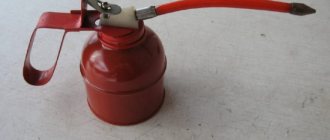Tools and materials
Remodeling will require a minimum set of tools:
- drill;
- Phillips screwdriver;
- scissors or nippers;
- thin soldering iron 30-40 watts;
Necessary materials for constructing Bluetooth speakers, in addition to speakers:
- 3.7V lithium-ion battery;
- bluetooth module BLK-MD-SPK-B (costs $10 on Ali);
- 3.5 mm jack;
- 3.5 mm plug;
- Wires, ideally - 4 different colors;
- Switch.
Additionally, you will need electrical tape, solder, soldering flux and hot glue (a good superglue will also work).
Connecting the wireless module
The image shown shows a chip for assembling a Bluetooth speaker with your own hands using BLK-MD-SPK-B. Pins 3 to 5 will be used for audio output, 13 and 12 for power.
3 - Speaker common wire.
4 - Positive wire left.
5 - Positive wire right.
12 - Power (+).
13 — Power (-).
The contacts of the module that I used are very small, so I had to solder very carefully so as not to damage them. The soldered board can be mounted inside the structure.
Installing Google API on Raspberry Pi
1. First, you need to register on the Google Console Actions dashboard.
2. After you register and log into your Google account, you should see the following window.
Click on Add/Import Project (add/import a new project).
3. In the next window, you need to enter a project name (Project Name) and then click on Create Project.
4. Then, in a new browser tab, open the Google developers console and search for the Google Assistant API. Make sure your project is selected there, then check the Enable checkbox. After that, click the Enable button.
5. Now open the previous browser tab with Google Console and scroll to the very bottom. There you will find the Device Registration option, click on it.
6. In the next window that opens, click on Register Model. After this, you will need to enter the Product Name, Manufacturer name and set the Device Type. You can enter any of these names at your discretion.
After this, write down the Device Model Id (device model identifier) - we will need it later, and click on Register Model.
7. On the next screen you will be prompted to download the certificate (Download Credentials). To download the certificate, click the Download OAuth 2.0 credentials button. This downloaded certificate file is very important, so keep it in a safe place. Then click Next.
8. Next, you can set some features/traits of the project, but we will not do this, so click the Skip button.
9. Once everything is done, you should see the following screen:
10. Next you need to open the page with Activity Controls. On this page you need to activate the following settings (activity controls) to make sure that the Google Assistant API will work correctly: - Web & App Activity; — Location History; — Device Information; — Voice & Audio Activity.
11. Next, switch back to Google developers console. Click on it on Credentials on the left side of the screen. Click on the OAuth consent screen.
12. Enter your Email address and any name in the Product name field and save the entered data.
This completes the Google API installation.
Battery connection
The next step is to attach 3 wires to the battery: a positive contact, a negative one and another wire to control the charge. All three will go to the 3.5 mm power connector, and the positive one will also go to the second contact on the power button.
Important! For charging, a constant voltage of 3.5-4 V and a charging current of at least 500 mA are suitable. You can use any suitable charger from an old mobile phone.
About working with Layer
Image: capsula.mail / design by Layer studio
“As a result, the London agency Layer and Benjamin Hubert personally helped us with the development of the device. We met his team in March last year. Before this, we painstakingly looked for partners all over the world. Then there was a tender in which they took part and won us over with their expertise and approach to work.
At all stages of development, the task was to create the most expressive visual language with a minimum number of details, which would ensure the high value of the device. Design is one of the main factors, due to which the product must outperform competitors.
In April, Layer began creating concepts, selecting the most suitable options, and finalizing the final version of the device. For the chosen concept, it was necessary to determine colors, materials, and work out all the details. In total, Layer drew eight concepts.
They formed a vision for materials: they did not agree to compromises such as choosing simpler fabrics, refusing silicone inserts or other soft materials - this would increase the cost of the speaker and make it less beautiful.”
Functionality check
Once the assembly is complete, it's time to turn on bluetooth on your phone or other source and start searching for wireless equipment nearby. If you are asked for a password when connecting to a new gadget, use the standard four zeros. By the way, such a speaker can easily be connected to an Honor phone or other device.
That's all, you've made a fairly powerful Bluetooth speaker with your own hands, and then a new life begins without wires.
Options for portable Bluetooth speakers that you can make yourself
There are many variations in assembling Bluetooth speakers. You can use not four, but two identical speakers, to which the same sound will be supplied. Such a device will have smaller dimensions, but the sound quality will be somewhat worse.
There are also variations of the build with two tweeters and one large subwoofer.
Whether a speaker is powerful or not depends on its components.
REFERENCE! The larger the size and power of the speakers, the greater the battery capacity will be needed to maintain normal operation of the device.
If the user needs a very small portable speaker, then such a device can be assembled using only one speaker. To do this, you only need the speaker itself, a battery (can be used from an old phone), a Bluetooth module, a charging module, an amplification stage and a power switch.
- First of all, you need to place the battery in the case. Connect the charge module to it, which is equipped with two LEDs signaling the charging process.
- The Bluetooth module and amplification stage should also be connected to the battery. The element to provide wireless communication must be connected via a power switch.
- From the Bluetooth component, the signal will be sent to the speaker through an amplifier. The module itself has corresponding outputs that should be connected, observing the polarity.
External speaker from a smartphone
I told you how to make a bluetooth speaker from a regular one. But you can play sound through any smartphone. For example, if your laptop audio system breaks down at the most inopportune moment. To do this, you don’t need a soldering iron, wires, or purchasing microcircuits in China. A special application for Android or iOS is enough. There are a lot of such programs today, you can choose any one to your liking. For example, I'll talk about w.
This application is shareware. That is, it is quite possible to use it and not pay anyone, but in this case, every 45 minutes the signal will be interrupted by a not very pleasant sound and a block of advertising. $3 for the full version will remove the limit and give you good compression as a bonus, as well as the ability to make multiple connections simultaneously.
So, how to make a Bluetooth speaker from your phone yourself?
- Download SoundWire to your computer from the official website and to your smartphone from Google Play.
- We launch it on both devices and wait until they detect each other.
- In the computer version, select the sound source from those found.
- Enjoy solving the problem!
If any of the steps remain unclear, all stages of assembling a Bluetooth speaker with your own hands can be easily found in the video on the Internet or below.
Using Google Assistant on Raspberry Pi
Previously, we successfully authorized Raspberry Pi to Google Assistant. Now, whenever you want to launch Google Assistant, you will need to complete the following sequence of steps:
1. Execute the command to launch the Google Assistant environment.
Shell
| 1 | source env/bin/activate |
After this, you will see a prompt (env) at the beginning of each line.
2. To start a conversation with the assistant (conversation sample, sample), run the following command:
Shell
| 1 | googlesamples-assistant-pushtotalk |
This time, when executing this command, we no longer need to enter the product id (product identifier) and device id (device identifier).
3. You can also start a conversation with Google Assistant by saying Ok Google. To do this you need to enter an incorrect device id. For example, you can enter aaaa, abcd as device id.
Run the following command:
Shell
| 1 | googlesamples-assistant-hotword —device-model-id<deviceid> |
Now you can ask Google assistant anything you want just by saying Ok Google.
In order to turn our project into a smart speaker, we need to connect a speaker and microphone to the Raspberry Pi board.











